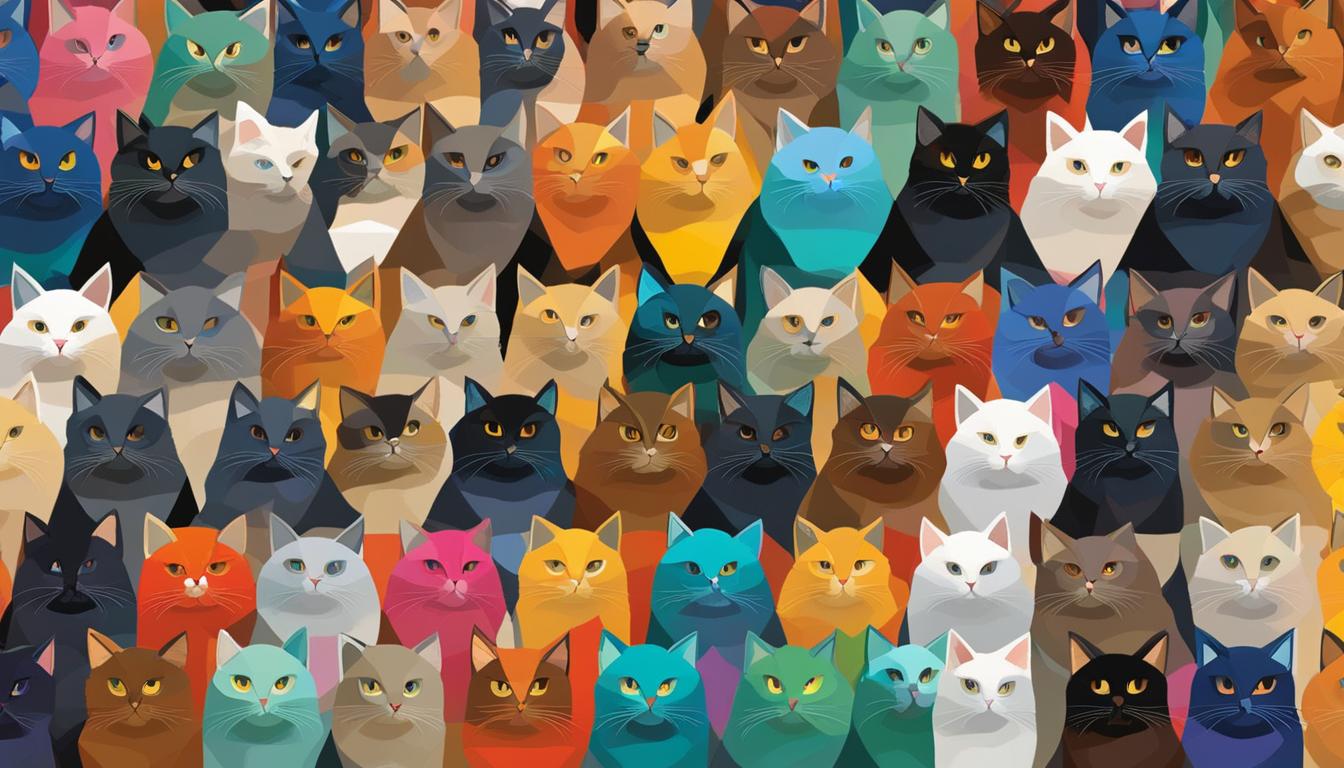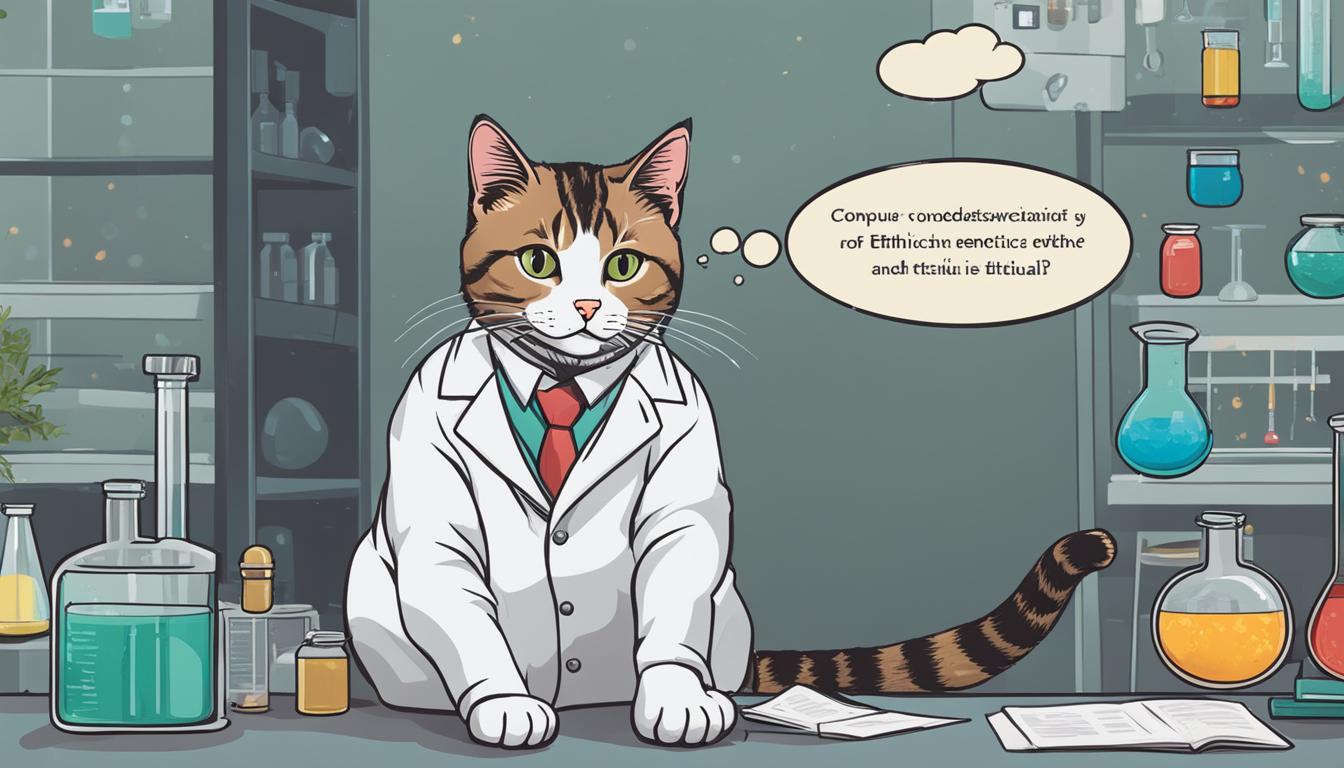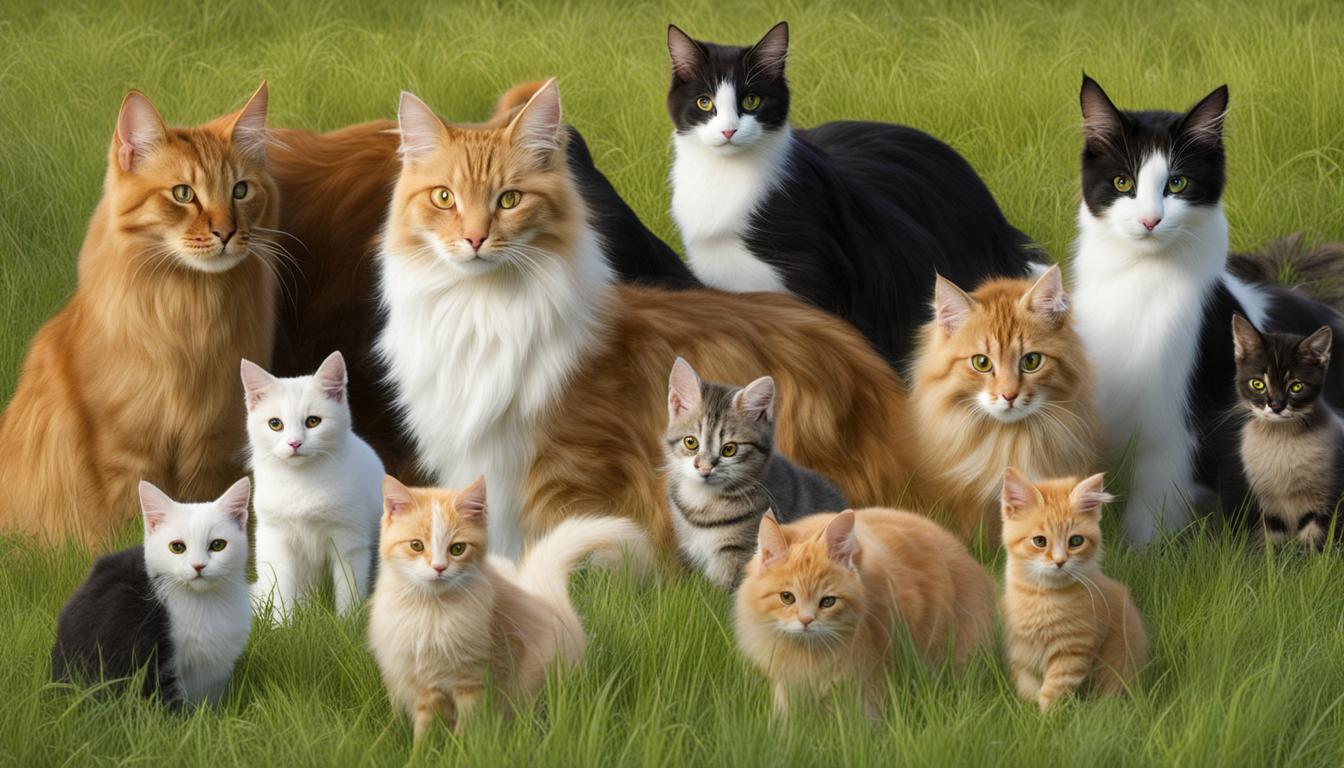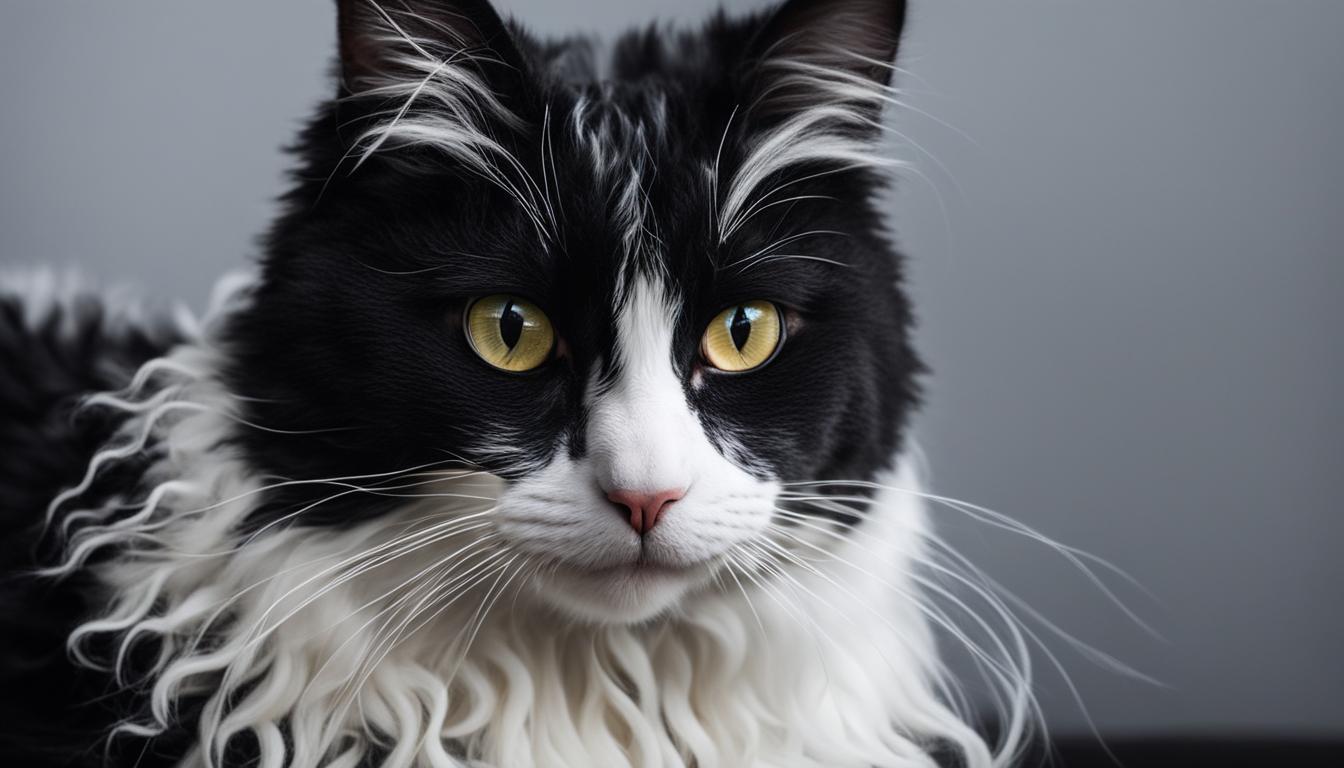Genetic diversity in cat breeds is a fascinating subject that has captivated the attention of researchers worldwide. As a cat lover, I’ve always been curious about the genetic variation that exists within different cat breeds. From the regal Maine Coon to the playful Siamese, each breed boasts its own unique characteristics and traits.
Exploring the genetic analysis of popular cat breeds can provide valuable insights into their origins and relationships. Not only does it shed light on the fascinating history of domestic cats, but it also helps us better understand their health and potential genetic diseases.
Key Takeaways:
- Genetic diversity plays a crucial role in understanding the origins and relationships among different cat breeds.
- Pure breeding can lead to a loss of genetic diversity, highlighting the importance of responsible breeding practices.
- Genetic marker-based strategies can accurately identify the breed or population of origin for most cats, enhancing healthcare management.
- The Mediterranean basin is believed to be the likely site of domestication for cats, with distinct genetic clustering observed in different regions of the world.
- Studying genetic diversity within cat breeds contributes to our knowledge of feline genetics and aids in predicting and preventing genetic diseases.
The Origins of Domestic Cats
Have you ever wondered where our beloved domestic cats came from? It’s a fascinating journey that traces back thousands of years to the ancient civilizations of the Near East. Around 9,000-10,000 years ago, as humans transitioned from hunter-gatherer societies to agricultural ones, a unique partnership began to form between humans and cats.

As agriculture developed, so did the problem of crop-destroying rodents. Cats played a crucial role in controlling these pests, and humans recognized their value. This mutual benefit led to a growing tolerance for cats among the early farmers, eventually leading to their domestication.
The early domestic cats spread as humans migrated along trade routes, reaching different parts of the world. Despite their travels, these cats remained genetically similar to their wild ancestors, retaining their self-sufficiency and hunting skills. This is why the modern cat is considered semi-domesticated, as it still possesses many of the traits that allowed it to survive in the wild.
Table: Ancient Civilizations and Cat Domestication
| Ancient Civilization | Timeline | Significance |
|---|---|---|
| Egypt | Approximately 4,000 years ago | Worshipped cats as sacred beings; depicted them in art and mythology |
| Rome | 1st century BC | Kept cats as pets to control pests and admired their beauty |
| China | Between 5th and 3rd centuries BC | Associated cats with good luck and fortune; kept them as companions |
| Vikings | 8th to 11th centuries AD | Believed cats brought luck and protection; kept them on their long voyages |
The ancient civilizations of Egypt, Rome, China, and the Vikings all revered and appreciated cats in their own unique ways. In Egypt, cats were worshipped as sacred beings and were even mummified upon their death. The Romans admired the beauty of cats and kept them as pets to control pests in their homes. In China, cats were associated with good luck and fortune, and were kept as cherished companions. The Vikings believed that cats brought luck and protection, and they were kept on their long voyages.
Understanding the origins of domestic cats gives us a glimpse into the deep historical connection between humans and these fascinating feline creatures. The bond between humans and cats formed thousands of years ago continues to thrive, reminding us of the enduring legacy of our feline friends.
Genetic Relationships and Clustering of Cat Populations
Understanding the genetic relationships and clustering of cat populations provides valuable insights into the origins and diversity of domestic cats. A Bayesian analysis using the software Structure revealed distinct genetic clusters in random-bred cat populations. These clusters were found in Europe, the Mediterranean basin, East Africa, and Asia, indicating unique genetic relationships among these populations. This phylogeographical structure highlights the complex history and genetic diversity of domestic cats.
Genetic clustering is an important aspect of cat breed phylogeography. By analyzing the genetic data of cat populations, researchers can determine the genetic relationships between different breeds and their geographic origins. This information not only sheds light on the evolutionary history of cat breeds but also helps in identifying the genetic signatures associated with specific breeds.
The Bayesian analysis of random-bred cat populations using the software Structure revealed four genetic clusters: Europe, the Mediterranean basin, East Africa, and Asia.
The identification of these distinct genetic clusters has practical implications for cat breeders and geneticists. By understanding the genetic relationships between different populations, breeders can make informed decisions about breeding programs, ensuring genetic diversity and promoting the overall health of cat breeds. Additionally, genetic clustering can aid in the identification of potential health risks associated with certain breeds, allowing for proactive measures to be taken in disease prevention and management.
Table: Genetic Clusters of Cat Populations
| Genetic Cluster | Geographic Region |
|---|---|
| Europe | Various countries in Europe |
| Mediterranean Basin | Coastal regions surrounding the Mediterranean Sea |
| East Africa | Countries in East Africa |
| Asia | Various countries in Asia |
The table above summarizes the genetic clusters of cat populations, highlighting their respective geographic regions. This visual representation offers a clear overview of the genetic diversity and clustering observed in domestic cats across different parts of the world.

Overall, the study of genetic relationships and clustering in cat populations provides fascinating insights into the intricate history and diversity of domestic cats. By delving into the genetic structure of different populations, researchers and breeders can make informed decisions about the preservation and management of cat breeds, ensuring their longevity and well-being.
Breed Development and Genetic Variation
When it comes to genetic variation, pedigreed cat populations often exhibit interesting patterns. The development of specific cat breeds has led to the establishment of distinct genetic pools for each breed, resulting in unique genetic signatures. Many cat breeds can be traced back to “foundation” breeds, which form breed families or groups. However, it is important to note that not all cats identified as the same breed are genetically alike, highlighting the complexity of breed development and genetic variation.
Genetic studies have revealed that some breeds share health concerns due to their genetic similarity, while others may have specific genetic variations that can lead to unique health problems. For example, some breeds are more prone to certain inherited diseases or conditions due to their genetic makeup. Understanding the genetic background and vulnerabilities of each breed is crucial for predicting and preventing potential health issues.
In the world of cats, genetic variation is not solely determined by breed. Within each breed, there can still be a wide range of genetic diversity. This variation can be attributed to factors such as outcrossing, where breeders introduce new genetic material into a breed to maintain genetic health and diversity. Additionally, natural genetic mutations can occur within a breed, leading to new traits or characteristics.
Overall, studying breed development and genetic variation is essential for maintaining the health and wellbeing of pedigreed cat populations. By understanding the genetic signature of each breed and monitoring for potential health concerns, breeders and veterinarians can work together to protect and preserve the unique qualities of these beloved feline companions.
| Breed | Genetic Signature | Potential Health Concerns |
|---|---|---|
| Maine Coon | Large size, tufted ears, bushy tail | Hypertrophic cardiomyopathy, hip dysplasia |
| Persian | Flat face, long coat | Polycystic kidney disease, respiratory issues |
| Siamese | Blue eyes, color-point pattern | Progressive retinal atrophy, dental issues |
Genetic Marker-Based Breed Identification Strategy
When it comes to determining the breed of a cat, genetic marker-based breed identification offers an accurate and reliable solution. Through the use of cat breed DNA testing and DNA markers specific to different breeds, it is now possible to identify a cat’s breed or population of origin with high precision.
Research has shown that the frequentist method developed by Paetkau can effectively assign individuals to the correct breed. This method has been found to be more accurate than the Bayesian method proposed by Rannala and Mountain. Additionally, the inclusion of phenotypic single nucleotide polymorphisms (SNPs) further enhances the accuracy of breed assignment.
“Genetic marker-based breed identification has revolutionized our ability to determine a cat’s breed. By analyzing specific DNA markers, we can uncover the unique genetic signatures of different breeds, allowing for accurate identification and tracing of a cat’s lineage.”
The process of genetic marker-based breed identification involves multiple steps. First, DNA samples are collected from the cat, typically through a cheek swab or blood test. Then, these samples are analyzed using various genetic markers that are known to be associated with specific breeds. By comparing the cat’s genetic profile to a database of known breed markers, the breed or population of origin can be accurately determined.
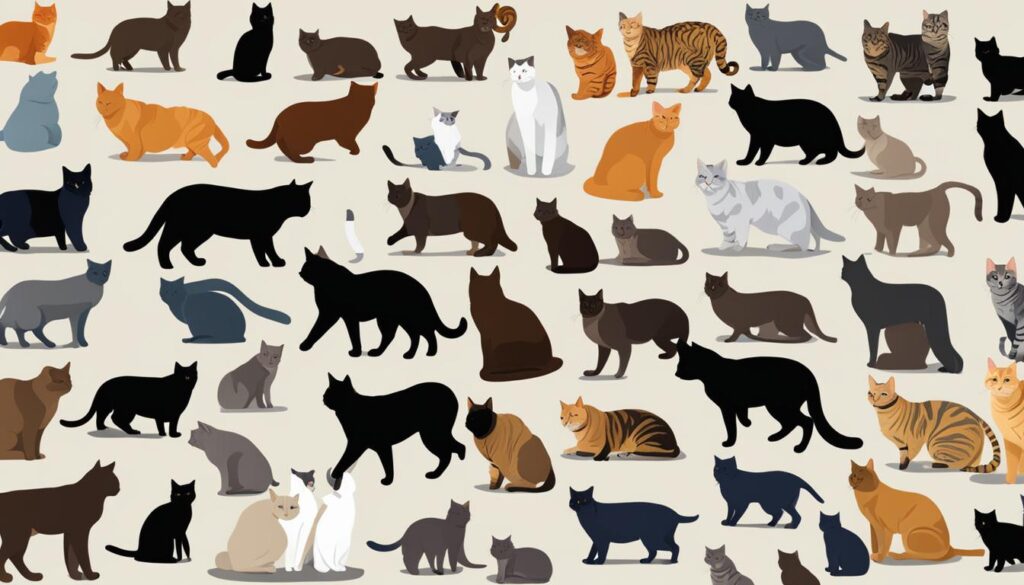
Benefits of Genetic Marker-Based Breed Identification
- Accurate breed identification: Genetic marker-based methods offer a reliable way to determine a cat’s breed or population of origin.
- Healthcare management: Understanding a cat’s breed can provide valuable insights into potential health concerns and enable targeted healthcare for specific breeds.
- Breeding programs: Breeders can use genetic marker-based breed identification to ensure proper lineage and make informed breeding decisions.
| Genetic Marker-Based Breed Identification Strategies | Advantages |
|---|---|
| Frequentist method by Paetkau | More accurate than the Bayesian method |
| Inclusion of phenotypic SNPs | Improves accuracy of breed assignment |
Overall, genetic marker-based breed identification has revolutionized our understanding of cat breeds and their genetic diversity. With its accuracy and reliability, this technique has become an essential tool in the world of cat genetics and breeding.
Conclusion
After delving into the fascinating world of genetic diversity in cat breeds, it is evident that these furry creatures hold a rich tapestry of origins and relationships. Through extensive research, we have discovered that the Mediterranean basin serves as the likely birthplace of domesticated cats, while distinct genetic clustering can be observed in various parts of the world.
One striking revelation is the impact of pure breeding on genetic diversity. Unfortunately, it has led to a loss of genetic variation in certain breeds. This emphasizes the importance of understanding the genetic background of each breed to effectively manage their healthcare and predict and prevent genetic diseases.
Fortunately, with the advancements in genetic marker-based strategies, accurate identification of a cat’s breed or population of origin is now possible. These highly reliable techniques allow us to uncover the hidden genetic secrets within our feline friends. By utilizing frequentist methods and phenotypic single nucleotide polymorphisms (SNPs), we can assign cats to their rightful breed with precision.
In conclusion, the study of genetic diversity in cat breeds not only satisfies our curiosity about their origins but also plays a critical role in their well-being. By unraveling the genetic mysteries, we can ensure the health and happiness of our beloved feline companions for generations to come. So, next time you gaze into the eyes of your furry friend, remember the fascinating genetic journey that brought them into your life.
FAQ
What is genetic diversity in cat breeds?
Genetic diversity refers to the variation in genetic traits within a population. In the context of cat breeds, it refers to the differences in DNA sequences and genetic markers among different breeds and populations.
How has the genetic diversity of cat breeds been studied?
Scientists have conducted extensive genetic studies using DNA data from various cat populations and breeds. These studies analyze genetic markers and clustering patterns to understand the relationships and origins of different cat populations.
Where were cats likely domesticated?
The domestication of cats is believed to have started in the Near East, specifically in the Mediterranean region. This is based on genetic studies that have shown distinct genetic clustering in the Mediterranean basin.
Are all cat breeds genetically alike?
No, genetic studies have shown that not all cats identified as the same breed are genetically similar. While some breeds share genetic characteristics, others may have specific genetic variations that can lead to unique health problems.
How accurate are genetic marker-based breed identification strategies?
Genetic marker-based strategies have been found to be accurate in identifying the breed or population of origin for most cats. The use of DNA markers, combined with phenotypic single nucleotide polymorphisms (SNPs), improves the accuracy of breed assignment.

